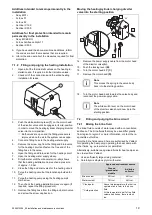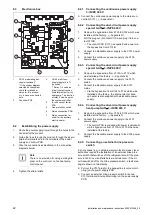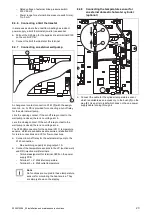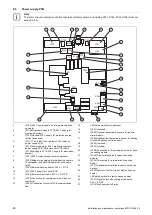
0020213394_05 Installation and maintenance instructions
9
condenser (which works as an evaporator when in cooling
mode). This heat energy is absorbed by the refrigerant and
heated to a higher temperature level using the compressor.
The heat energy is then delivered to the brine in the evapor-
ator (which works as a condenser when in cooling mode).
The cooled refrigerant is guided to the expansion valve to
enable heat energy to be absorbed from the condenser
again. The brine pump feeds the warm brine to the air-to-
brine collector. The heat energy is dissipated to the outdoor
air.
During the installation, it may be useful to exclude some
rooms (e.g. the bathroom) from the cooling function and to
actuate isolation valves especially for this. The heat pump
electronics system emits a signal that can be used for actu-
ating these.
A passive cooling module is also available as an alternative,
whereby heat energy is transported via underfloor heating,
for example, from the rooms to the ground without the com-
pressor operating and therefore without the refrigerant circuit
operating.
If required, the integrated electric back-up heater can be
activated at different output levels via the heat pump display.
The electric back-up heater is then actuated by the system
control.
3.2.2
Weather-compensated system control
The heat pump system is equipped with a weather-com-
pensated system control that provides the heating, cooling
and domestic hot water mode depending on the control type
and controls this in automatic mode.
The control changes the target flow temperature based on
the outdoor temperature. The outdoor temperature is meas-
ured by a separate sensor which is installed outdoors, and
the results are transmitted to the control. The room temper-
ature depends only on the preset values. The system com-
pensates for the effect of the outdoor temperature. Domestic
hot water generation is not affected by the weather com-
pensation. The instructions for the system control describe
how to install and operate the product.
3.2.3
Display of the energy consumption, energy
yields and efficiencies
The product, the system control and the app show approx-
imate values for energy consumption, energy yields and ef-
ficiencies, which are extrapolated based on calculation al-
gorithms.
The values that are displayed in the app may differ from the
other display options due to staggered transfer intervals.
The determined values depend on:
–
Installation and system of the heating installation
–
User behaviour
–
Seasonal weather effects
–
Various tolerances of unit-internal components
The recording of the values only includes the product in the
factory-delivered condition. Supplementary accessories,
even if they are installed on the product, as well as any other
components in the heating system and other external con-
sumers, are not part of the data recording.
Deviations between the determined values and the actual
values may be significant. The determined values are there-
fore not suitable for creating or comparing energy billing, for
example.
When replacing the PCB, the values for energy consump-
tion, energy yields and efficiencies are reset in the heat
pump's control panel.
3.3
Safety devices
3.3.1
Frost protection function
The frost protection function for the system is controlled via
the system control. If the system control fails, the heat pump
guarantees limited frost protection for the heating circuit.
3.3.2
Protection against low heating water
pressure
This function continuously monitors the pressure of the heat-
ing water in order to prevent a possible loss of heating water.
If the water pressure falls below the minimum pressure, an
analogue pressure sensor switches off the heat pump and
switches the other modules, where these exist, to standby
mode. The pressure sensor switches the heat pump on
again if the water pressure reaches the operating pressure.
–
Min. heating circuit pressure:
≥
0.05 MPa (
≥
0.50 bar)
–
Min. heating circuit operating pressure:
≥
0.07 MPa
(
≥
0.70 bar)
3.3.3
Brine pressure detector
The brine pressure detector continuously monitors the fluid
pressure in the environment circuit in order to prevent a pos-
sible shortage of fluid. If the fluid pressure falls below the
minimum pressure, an analogue pressure sensor switches
off the heat pump and switches the other modules, where
these exist, to standby mode. The pressure sensor switches
the heat pump on again if the fluid pressure reaches the op-
erating pressure.
–
Minimum brine fluid pressure:
≥
0.05 MPa (
≥
0.50 bar)
–
Min. brine fluid operating pressure:
≥
0.07 MPa
(
≥
0.70 bar)
3.3.4
Freeze protection
This function prevents the evaporator from freezing when the
heat source temperature drops below a certain value.
The outlet temperature of the heat source is constantly
measured. If the outlet temperature of the heat source falls
below a certain value, the compressor temporarily switches
off and displays a status message. If this fault occurs three
times in a row, it is switched off and a fault message is
displayed.
3.3.5
Pump- and valve-blocking protection system
This function prevents the pumps for heating water and
brine and all diverter valves from sticking. The pumps and
the valves, which were out of operation for 23 hours, are
switched on for 10 - 20 seconds, one after the other.
3.3.6
High-pressure pressure switch in the
refrigerant circuit
The high-pressure pressure switch shuts down the heat
pump if the pressure in the refrigerant circuit is too high. Fol-
lowing a waiting period, the heat pump attempts to start once
more. After three failed start attempts in succession, a fault
message is displayed.










































